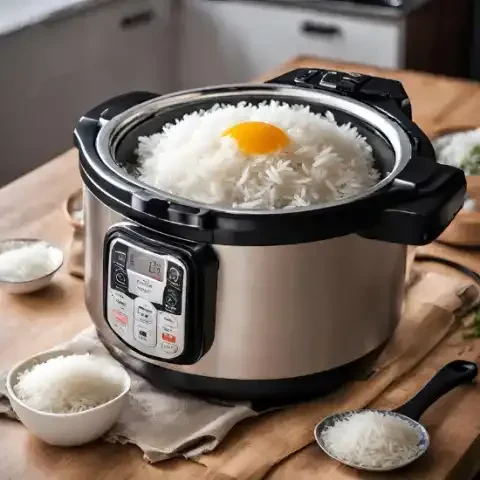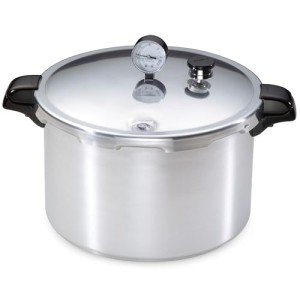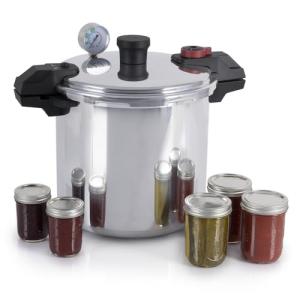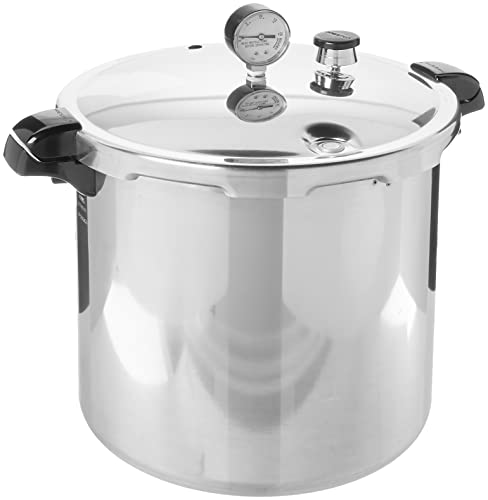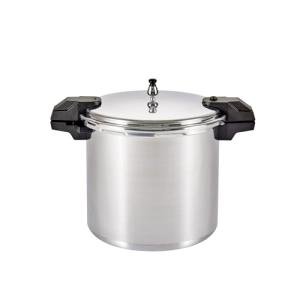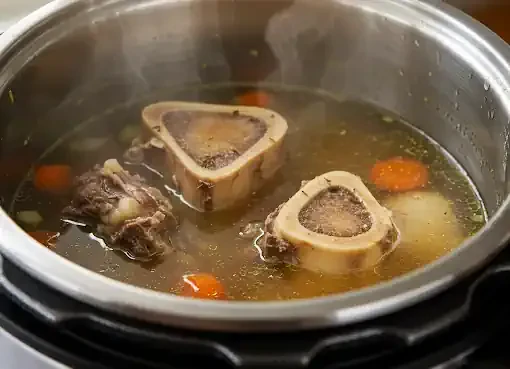Introduction
Pressure cookers have revolutionized the way we approach cooking, offering unparalleled convenience, efficiency, and versatility in the kitchen. Once known primarily for their ability to expedite the cooking process for tough cuts of meat or dried beans, pressure cookers have now become indispensable for a wide range of culinary tasks, including the preparation of perfectly cooked rice.
Rice, a staple food for billions worldwide, is a dietary cornerstone in many cultures. Traditionally, cooking rice required careful monitoring, precise measurements, and patience to achieve that ideal fluffy texture without it being mushy or undercooked. However, the advent of pressure cookers has simplified this process significantly, making it accessible even to those with limited culinary experience.
In this article, we delve into the world of pressure cooker rice – exploring its benefits, offering a step-by-step guide for preparation, providing tips for achieving optimal results, discussing variations and flavor enhancements, troubleshooting common issues, and ultimately, empowering you to master the art of cooking rice in a pressure cooker.
Pressure cooker rice is not merely a time-saving technique; it's a culinary revelation. By harnessing the power of steam and pressure, pressure cookers transform raw rice into perfectly cooked grains in a fraction of the time it takes using traditional methods. This efficiency not only saves precious minutes in the kitchen but also conserves energy, making pressure cookers an eco-friendly option for everyday cooking.
Furthermore, pressure cooking ensures unparalleled consistency in rice texture. No more dealing with unevenly cooked grains or dreaded burnt bottoms – the controlled environment of a pressure cooker guarantees uniform results every time. Whether you prefer fluffy white rice, nutty brown rice, fragrant jasmine rice, or any other variety, the pressure cooker can handle them all with ease.
Moreover, pressure cooking retains the nutritional integrity of rice, preserving essential vitamins, minerals, and fiber that may be lost through other cooking methods. This means not only does your rice taste great, but it's also good for you, contributing to a wholesome and balanced diet.
As we embark on this journey into the realm of pressure cooker rice, prepare to unlock a world of culinary possibilities. Whether you're a seasoned home cook looking to streamline your meal prep or a novice eager to expand your culinary repertoire, pressure cooker rice is a game-changer that promises to elevate your cooking experience to new heights. So, let's dive in and discover the secrets to perfect pressure cooker rice together.
Benefits of Cooking Rice in a Pressure Cooker
Rice is a dietary staple for billions of people worldwide, consumed as a primary source of carbohydrates and an essential component of countless dishes. Traditionally, cooking rice required a significant investment of time and attention, often resulting in inconsistent results and occasional frustration. However, with the advent of pressure cookers, the process of cooking rice has been streamlined and enhanced in numerous ways. In this section, we'll explore the myriad benefits of cooking rice in a pressure cooker.
Time-saving Efficiency
One of the most significant advantages of using a pressure cooker for rice preparation is the dramatic reduction in cooking time. Unlike conventional stovetop methods that can take upwards of 20-30 minutes or more, pressure cooking can produce perfectly cooked rice in a fraction of the time. Depending on the type of rice and the pressure cooker model, cooking times can be slashed by up to 50% or more, allowing you to enjoy fluffy, tender rice in a matter of minutes rather than waiting patiently for pots to boil and simmer.
This time-saving efficiency is particularly valuable for busy individuals and families who are juggling multiple responsibilities and time constraints. Whether you're whipping up a quick weeknight dinner or preparing a large batch of rice for meal prepping purposes, the speed and convenience of pressure cooker rice ensure that you can enjoy delicious, homemade rice-based dishes without sacrificing precious time or resorting to unhealthy convenience foods.
Energy-efficient Cooking
In addition to saving time, pressure cooker rice is also incredibly energy-efficient compared to traditional cooking methods. By harnessing the power of steam and pressure to rapidly cook food, pressure cookers require significantly less energy than conventional stovetop or oven-based cooking techniques. This translates to lower utility bills and reduced environmental impact, making pressure cookers an eco-friendly choice for environmentally conscious consumers.
Furthermore, the sealed environment of a pressure cooker prevents heat loss and minimizes the need for continuous monitoring and adjustment, further optimizing energy usage. Whether you're cooking rice for one or preparing a feast for a large gathering, the energy-efficient nature of pressure cooker rice ensures that you can enjoy delicious meals while minimizing your carbon footprint and contributing to sustainable living practices.
Consistency and Uniformity
One of the most frustrating aspects of traditional rice cooking methods is the lack of consistency and uniformity in the final product. Achieving that perfect balance of fluffy grains without clumping or stickiness requires precision and patience, often leading to disappointing results. However, pressure cooker rice eliminates this uncertainty by providing a controlled cooking environment that ensures consistent and uniform results every time.
The combination of high pressure and steam penetrates each grain of rice evenly, resulting in a perfectly cooked texture from edge to edge. Say goodbye to crunchy undercooked bits and soggy, overcooked mush – pressure cooker rice delivers a flawless consistency that satisfies even the most discerning palates. Whether you're serving rice as a side dish, incorporating it into soups or stews, or using it as a base for stir-fries and curries, the reliable consistency of pressure cooker rice guarantees a delightful dining experience with every bite.
Nutritional Preservation
In addition to its time-saving efficiency and consistency-enhancing properties, pressure cooker rice also boasts the advantage of nutritional preservation. Unlike some cooking methods that can leach nutrients from food or require excessive amounts of added fats and oils, pressure cooking helps retain the natural vitamins, minerals, and fiber present in rice.
The sealed environment of a pressure cooker locks in essential nutrients, preventing them from being lost to evaporation or degradation during the cooking process. This means that pressure cooker rice not only tastes delicious but also provides valuable nourishment, contributing to a healthy and balanced diet. Whether you're fueling up for a busy day ahead or replenishing your body after a workout, you can feel confident knowing that pressure cooker rice offers both flavor and nutrition in every serving.
In summary, the benefits of cooking rice in a pressure cooker are abundant and undeniable. From time-saving efficiency and energy-efficient cooking to consistency and nutritional preservation, pressure cooker rice offers a host of advantages that elevate the cooking experience and delight the taste buds. Whether you're a seasoned home chef or a novice cook just starting out, incorporating pressure cooker rice into your culinary repertoire is sure to revolutionize your approach to meal preparation and leave you wondering how you ever lived without it.
Getting Started: Equipment and Ingredients
Before diving into the process of cooking rice in a pressure cooker, it's essential to ensure you have the right equipment and ingredients on hand. In this section, we'll explore the necessary tools and ingredients for pressure cooker rice preparation, including considerations for different types of rice and the importance of water-to-rice ratio.
Necessary Equipment
Pressure Cooker: The cornerstone of pressure cooker rice preparation is, of course, the pressure cooker itself. There are various types of pressure cookers available on the market, ranging from stovetop models to electric multi-cookers. Choose a pressure cooker that suits your preferences and cooking style, ensuring it is equipped with safety features such as pressure release valves and locking lids.
Measuring Cups: Accurate measurement is crucial when cooking rice, as the water-to-rice ratio directly impacts the final texture and consistency. Invest in a set of reliable measuring cups to ensure precise measurements and consistent results.
Rice: The type of rice you choose will influence the cooking time and water requirements. Common varieties of rice suitable for pressure cooker cooking include white rice, brown rice, jasmine rice, basmati rice, and sushi rice. Experiment with different types to discover your favorites and their unique characteristics.
Water: The amount of water needed to cook rice varies depending on the type of rice and personal preferences for texture. While most recipes call for a 1:1 water-to-rice ratio for white rice, brown rice typically requires slightly more water to achieve optimal results. Be sure to use clean, filtered water for the best flavor.
Types of Rice Suitable for Pressure Cooking
White Rice: White rice is the most common type of rice used for pressure cooker cooking due to its quick cooking time and versatile nature. Whether you prefer short-grain, medium-grain, or long-grain white rice, the pressure cooker can handle them all with ease.
Brown Rice: Brown rice is a nutritious whole grain that offers a nuttier flavor and chewier texture than white rice. While brown rice typically requires a longer cooking time and more water than white rice, the pressure cooker can expedite the process without sacrificing taste or texture.
Jasmine Rice: Jasmine rice is a fragrant variety of long-grain rice commonly used in Asian cuisine. Known for its floral aroma and slightly sticky texture, jasmine rice is an excellent choice for pressure cooker cooking, whether served as a side dish or used in stir-fries and curries.
Basmati Rice: Basmati rice is a long-grain rice variety with a distinct aroma and fluffy texture when cooked. Popular in Indian and Middle Eastern cuisine, basmati rice pairs perfectly with flavorful spices and aromatic herbs, making it an ideal candidate for pressure cooker preparation.
Water-to-Rice Ratio
The water-to-rice ratio is a critical factor in achieving perfectly cooked rice in a pressure cooker. While the exact ratio may vary depending on the type of rice and personal preferences, a general rule of thumb is to use a 1:1 ratio of water to white rice and a 1.25:1 ratio of water to brown rice.
For example, if you're cooking 1 cup of white rice, you would typically add 1 cup of water to the pressure cooker. Similarly, if you're cooking 1 cup of brown rice, you would use approximately 1.25 cups of water. Adjust the water-to-rice ratio slightly based on your desired rice texture – less water for firmer rice and more water for softer, stickier rice.
By ensuring you have the right equipment and ingredients on hand and understanding the water-to-rice ratio for different types of rice, you'll be well-prepared to embark on your pressure cooker rice cooking journey. In the next section, we'll delve into the step-by-step process of cooking rice in a pressure cooker, guiding you through each stage from preparation to serving.
Step-by-Step Guide to Pressure Cooker Rice
Cooking rice in a pressure cooker may seem intimidating at first, but with the right guidance, it's a straightforward process that yields consistently delicious results. In this section, we'll walk you through the step-by-step process of preparing rice in a pressure cooker, covering everything from prepping the rice to releasing pressure and serving it piping hot.
Preparing the Rice
Rinsing: Before cooking rice, it's essential to rinse it thoroughly under cold water to remove excess starch. Rinsing helps prevent the rice from becoming overly sticky or clumpy during cooking and results in fluffier grains. Place the rice in a fine-mesh strainer or colander and rinse it under running water until the water runs clear.
Soaking (Optional): While not necessary for all types of rice, soaking can help reduce cooking time and improve texture, especially for brown rice. If you choose to soak the rice, place it in a bowl and cover it with cold water. Let it soak for 20-30 minutes, then drain well before cooking.
Adding Water and Rice to the Pressure Cooker
Water-to-Rice Ratio: Measure the appropriate amount of water based on the type of rice you're using and your desired texture. As a general rule, use a 1:1 ratio of water to white rice and a 1.25:1 ratio of water to brown rice. For example, if you're cooking 1 cup of rice, add 1 cup of water for white rice or 1.25 cups of water for brown rice to the pressure cooker.
Combining Ingredients: Once you've measured the water, add it to the pressure cooker pot, followed by the rinsed and drained rice. Use a spatula or spoon to gently stir the rice and water together, ensuring the rice is evenly distributed in the pot and submerged in the water.
Locking the Lid and Setting Pressure Levels
Securing the Lid: Place the lid securely on the pressure cooker, ensuring that the sealing ring is properly in place and the pressure release valve is in the sealed position. Different pressure cooker models may have varying mechanisms for locking the lid, so refer to the manufacturer's instructions for guidance.
Selecting Pressure Levels: Depending on your pressure cooker model, you may have options for selecting pressure levels such as high pressure or low pressure. For most rice recipes, high pressure is recommended for faster cooking and optimal results. Consult your pressure cooker's manual for specific instructions on setting pressure levels.
Cooking Time
Timing Guidelines: The cooking time for rice in a pressure cooker varies depending on the type of rice and pressure cooker model. As a general rule, white rice typically cooks in 3-5 minutes under high pressure, while brown rice may require 20-25 minutes. Refer to your pressure cooker's manual for recommended cooking times or consult a reliable recipe for guidance.
Starting the Cooking Process: Once you've set the pressure level and cooking time, start the pressure cooker according to the manufacturer's instructions. The cooker will build up pressure, and the cooking process will begin automatically. Some pressure cookers may have pre-set cooking programs for rice, which you can select for added convenience.
Releasing Pressure and Allowing the Rice to Rest
Natural Release vs. Quick Release: After the cooking time is complete, you have the option to release the pressure from the cooker using either the natural release or quick release method. Natural release involves allowing the pressure to release naturally over time, which can take 10-15 minutes or more depending on the recipe. Quick release involves manually releasing the pressure using the pressure release valve, which can be done by carefully turning the valve to the venting position. Be cautious of the hot steam when using the quick release method.
Resting the Rice: Once the pressure has been fully released and the cooker's safety lock indicates that it's safe to open, carefully remove the lid and fluff the rice with a fork or rice paddle. Let the rice rest for a few minutes before serving to allow any excess moisture to evaporate and the flavors to meld together.
By following this step-by-step guide, you'll be well-equipped to prepare perfectly cooked rice in your pressure cooker every time. Whether you're serving it as a simple side dish or incorporating it into more complex recipes, pressure cooker rice is sure to impress with its fluffy texture, vibrant flavor, and effortless preparation. In the next section, we'll explore some valuable tips for achieving optimal results and troubleshooting common issues when cooking rice in a pressure cooker.
Tips for Perfect Pressure Cooker Rice
While cooking rice in a pressure cooker is relatively straightforward, incorporating a few key tips and techniques can help elevate your results from good to great. In this section, we'll share valuable insights and strategies for achieving perfect pressure cooker rice every time, covering everything from adjusting cooking times to enhancing flavor and texture.
Adjusting Cooking Times Based on Altitude
Understanding Altitude: The altitude at which you're cooking can affect the cooking time and water absorption of rice. At higher altitudes, water boils at a lower temperature, which can result in longer cooking times and increased water evaporation. Conversely, at lower altitudes, water boils at a higher temperature, which may require shorter cooking times and less water.
Making Adjustments: If you live at a high altitude (above 3,000 feet), consider increasing the cooking time slightly and adding a bit more water to compensate for the lower boiling point of water. Conversely, if you're cooking at a lower altitude, you may need to reduce the cooking time and water slightly to prevent overcooking.
Using Natural Release vs. Quick Release Method
Understanding the Difference: The choice between natural release and quick release methods can impact the final texture of your rice. Natural release allows the pressure to release gradually on its own, which can result in softer, more tender grains. Quick release, on the other hand, rapidly releases the pressure, which may yield firmer grains.
Selecting the Right Method: Consider the desired texture of your rice when choosing between natural release and quick release. For softer, stickier rice, opt for natural release, allowing the grains to steam and absorb any remaining moisture. For firmer, separate grains, use the quick release method to halt the cooking process and prevent overcooking.
Fluffing the Rice for Optimal Texture
Fluffing Technique: After the pressure has been fully released and it's safe to open the cooker, use a fork or rice paddle to fluff the rice gently. Fluffing helps separate the grains and release excess steam, resulting in a light and airy texture.
Avoid Overmixing: Be careful not to overmix or stir the rice excessively, as this can cause it to become gummy or mushy. Use a light hand and gently fluff the rice, allowing it to retain its individual grains and delicate texture.
Preventing Rice from Sticking to the Bottom of the Cooker
Proper Water-to-Rice Ratio: Ensuring the correct water-to-rice ratio is crucial for preventing rice from sticking to the bottom of the pressure cooker. Use the recommended ratio for your chosen type of rice, and avoid adding too much or too little water.
Using a Nonstick Pot: If you consistently struggle with rice sticking to the bottom of the cooker, consider using a nonstick pot or insert. Nonstick surfaces help prevent rice from adhering to the bottom, making cleanup easier and reducing the risk of burnt or scorched rice.
Flavor Enhancements and Variations
Adding Aromatics: Elevate the flavor of your rice by adding aromatics such as garlic, onions, ginger, or herbs to the cooking water. These aromatic ingredients infuse the rice with delicious flavor as it cooks, enhancing the overall taste of the dish.
Incorporating Broth or Coconut Milk: For an extra layer of richness and depth, substitute some or all of the water with vegetable broth, chicken broth, or coconut milk. The broth adds savory notes, while coconut milk lends a creamy texture and tropical flavor to the rice.
Experimenting with Mix-Ins: Get creative with mix-ins by adding diced vegetables, cooked beans, toasted nuts, or shredded protein to the rice before cooking. These additions not only enhance the nutritional value of the dish but also add texture and complexity to your meals.
Exploring Different Rice Varieties: Don't limit yourself to just one type of rice – experiment with different varieties such as basmati, jasmine, wild rice, or black rice to discover new flavors and textures. Each type of rice offers unique characteristics that can enhance your culinary creations and broaden your culinary horizons.
By incorporating these tips and techniques into your pressure cooker rice cooking routine, you'll be well-equipped to achieve perfect results with every batch. Whether you're a seasoned chef or a novice cook, mastering the art of pressure cooker rice opens up a world of culinary possibilities and ensures that every meal is a delicious and satisfying experience. In the next section, we'll address common issues that may arise during pressure cooker rice preparation and provide practical solutions for troubleshooting them effectively.
Troubleshooting Common Issues
While cooking rice in a pressure cooker is generally a straightforward process, occasional challenges may arise that require troubleshooting to ensure optimal results. In this section, we'll address common issues that may occur during pressure cooker rice preparation and provide practical solutions to overcome them effectively.
Rice Turning Out Too Mushy or Too Dry
Adjusting Water-to-Rice Ratio: If your rice consistently turns out mushy, you may be using too much water. Try reducing the amount of water slightly to achieve a firmer texture. Conversely, if your rice is too dry or undercooked, increase the water slightly to ensure proper hydration and cooking.
Checking Cooking Time: Overcooking can also lead to mushy rice, especially if using high-pressure settings for too long. Reduce the cooking time or switch to low-pressure settings for a firmer texture. Conversely, if your rice is undercooked, increase the cooking time accordingly.
Dealing with Burn Signals in the Pressure Cooker
Monitoring Liquid Levels: Burn signals occur when the pressure cooker detects insufficient liquid or food stuck to the bottom of the pot, which can lead to scorching or burning. Ensure that there is enough liquid in the pot and that the rice is evenly distributed to prevent burning. If necessary, add additional liquid or deglaze the pot before restarting the cooking process.
Using Pot-in-Pot Method: To minimize the risk of burning, consider using the pot-in-pot method, where the rice is cooked in a separate container placed inside the pressure cooker. This method provides a buffer between the rice and the bottom of the pot, reducing the likelihood of burning and ensuring even cooking.
Adjusting Cooking Times for Different Altitudes
Increasing Cooking Time at High Altitudes: If you live at a high altitude, cooking times may need to be adjusted to account for lower atmospheric pressure. Increase the cooking time slightly and add extra liquid as needed to compensate for the reduced boiling point of water.
Decreasing Cooking Time at Low Altitudes: Conversely, if you're cooking at a low altitude, you may need to decrease the cooking time slightly to prevent overcooking. Monitor the rice closely and adjust the cooking time as necessary to achieve the desired texture.
Checking for Proper Sealing of the Pressure Cooker Lid
Ensuring Proper Sealing: A properly sealed pressure cooker is essential for maintaining pressure and achieving optimal cooking results. Before starting the cooking process, ensure that the sealing ring is properly in place and that the pressure release valve is in the sealed position. Check for any signs of damage or wear on the sealing ring and replace it if necessary.
Troubleshooting Leaks: If you experience leaks or steam escaping from the pressure cooker during cooking, inspect the sealing ring and pressure release valve for any defects or obstructions. Tighten the lid securely and adjust the pressure release valve as needed to prevent steam from escaping.
By implementing these troubleshooting techniques, you'll be better equipped to overcome common challenges and achieve perfect pressure cooker rice every time. Remember to adjust cooking times, water-to-rice ratios, and pressure settings as needed to accommodate different types of rice, altitudes, and pressure cooker models. With a little practice and experimentation, you'll soon master the art of pressure cooker rice and enjoy delicious, perfectly cooked grains with ease.
Conclusion Pressure Cooker Rice
In the realm of culinary convenience and versatility, pressure cooker rice stands as a shining example of how modern technology can revolutionize traditional cooking methods. Throughout this article, we've explored the many benefits, techniques, and tips for achieving perfect pressure cooker rice, empowering you to create delicious and satisfying meals with ease.
From its time-saving efficiency and energy-efficient cooking to its consistent texture and nutritional preservation, pressure cooker rice offers a host of advantages that make it a staple in kitchens around the world. Whether you're a busy professional seeking quick and nutritious meal solutions or a home cook looking to streamline your cooking process, the pressure cooker is a valuable tool that delivers flavorful and perfectly cooked rice every time.
By understanding the fundamentals of pressure cooker rice preparation – from selecting the right equipment and ingredients to adjusting cooking times and troubleshooting common issues – you can embark on a culinary journey filled with endless possibilities. Whether you're cooking fluffy white rice for a simple side dish, nutty brown rice for a wholesome grain bowl, or fragrant jasmine rice for an exotic curry, the pressure cooker is your ally in the kitchen, ensuring consistent and reliable results with minimal effort.
As you continue to explore the world of pressure cooker rice, don't hesitate to experiment with different varieties, flavors, and techniques to suit your preferences and culinary aspirations. Whether you're adding aromatics for extra flavor, incorporating mix-ins for added texture, or exploring international rice varieties for new taste sensations, the pressure cooker provides a canvas for culinary creativity and innovation.
In closing, I invite you to embrace the art of pressure cooker rice and discover the joy of effortless and delicious cooking. With a bit of practice, patience, and a willingness to experiment, you'll soon become a master of pressure cooker rice, delighting your family and friends with delectable meals that showcase the versatility and convenience of this modern kitchen essential. So, fire up your pressure cooker, grab your favorite rice variety, and let the culinary adventure begin!
